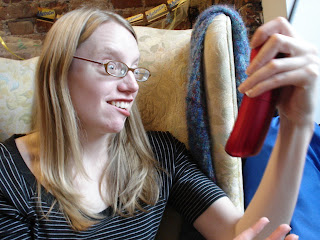People who attended my talk at the L.A. SCBWI Writer's Day in August may have noticed that I have not yet posted said talk to my website as promised. Part of the reason is personal -- I need to carve out the time to wrangle the thing online -- but part of it is technical, too: The Grand Conclusion to the talk was the layouts to a 32-page picture book I wrote, designed, and art-directed, illustrated with digital pictures; and this file, in PowerPoint form, is 10 MB. I really want to put these layouts online -- ideally with each spread in an individual page on my website, so I can put my commentary below the spread -- but the picture files alone will overwhelm my poor website. . . . Any ideas? Should I convert it to a PDF and just let people download it? Is there some easy way to make all the pictures lo-res? Or should I simply buy more webspace (which my thrifty Midwestern heart balks at)? What's the easiest way for me to get everything online?
I've been thinking about going to a new web server altogether when my DSL contract is up in August -- so, for instance, each individual page could have a nice web address like www.cherylklein.com/talks/moralsmuddles.html rather than the mysite.verizon.com/23743blah that's there now (if you can find an individual web address at all). If you have recommendations in this direction, please let me know.
Incidentally, these are the kind of illustrative delights that await you in the picture book:
 Believe it or not, this is neither the goofiest nor the ugliest picture of me in the book, though it is the one that makes me laugh the most; and the person who comes up with the best caption for the photo wins a Fall 2007 Arthur A. Levine ARC of their choice.
Believe it or not, this is neither the goofiest nor the ugliest picture of me in the book, though it is the one that makes me laugh the most; and the person who comes up with the best caption for the photo wins a Fall 2007 Arthur A. Levine ARC of their choice.
On a completely different note, after tonight's child_lit dinner I was talking with Victoria Stapleton of Little, Brown about David Foster Wallace's latest essay collection. The apparatus of footnotes attached to that gentleman's work reminded me of an amazing display I saw in the Jewish Museum a few years ago labeling all the various parts of a Talmud: the Talmud text itself at the center, with one commentary arching over the right, another on the left, glosses and other commentaries framing it below, notes spidering up the side. . . . I mean absolutely no disrespect by this, and I hope no one will take it so, but I think it would be absolutely fascinating to try to write and lay out a story (or a collection of stories) in this way: the main story in the center, related stories on each side, backstories or nonfiction commentaries below. Wouldn't that be cool to read and to follow?
The stories would probably have to be about Judaism or the Talmud in some way, in order to make full meaningful effect of the structure (paging Jonathan Safran Foer -- though Victoria said some commentaries on classical texts are also laid out this way? Still, the content of the stories would have to relate to the form in some manner). But I am neither a classical or Judaic scholar, so I will never write this; and therefore I offer the idea free to the world, and to any of you. If you do something with it, let me know.
I've been thinking about going to a new web server altogether when my DSL contract is up in August -- so, for instance, each individual page could have a nice web address like www.cherylklein.com/talks/moralsmuddles.html rather than the mysite.verizon.com/23743blah that's there now (if you can find an individual web address at all). If you have recommendations in this direction, please let me know.
Incidentally, these are the kind of illustrative delights that await you in the picture book:
On a completely different note, after tonight's child_lit dinner I was talking with Victoria Stapleton of Little, Brown about David Foster Wallace's latest essay collection. The apparatus of footnotes attached to that gentleman's work reminded me of an amazing display I saw in the Jewish Museum a few years ago labeling all the various parts of a Talmud: the Talmud text itself at the center, with one commentary arching over the right, another on the left, glosses and other commentaries framing it below, notes spidering up the side. . . . I mean absolutely no disrespect by this, and I hope no one will take it so, but I think it would be absolutely fascinating to try to write and lay out a story (or a collection of stories) in this way: the main story in the center, related stories on each side, backstories or nonfiction commentaries below. Wouldn't that be cool to read and to follow?
The stories would probably have to be about Judaism or the Talmud in some way, in order to make full meaningful effect of the structure (paging Jonathan Safran Foer -- though Victoria said some commentaries on classical texts are also laid out this way? Still, the content of the stories would have to relate to the form in some manner). But I am neither a classical or Judaic scholar, so I will never write this; and therefore I offer the idea free to the world, and to any of you. If you do something with it, let me know.